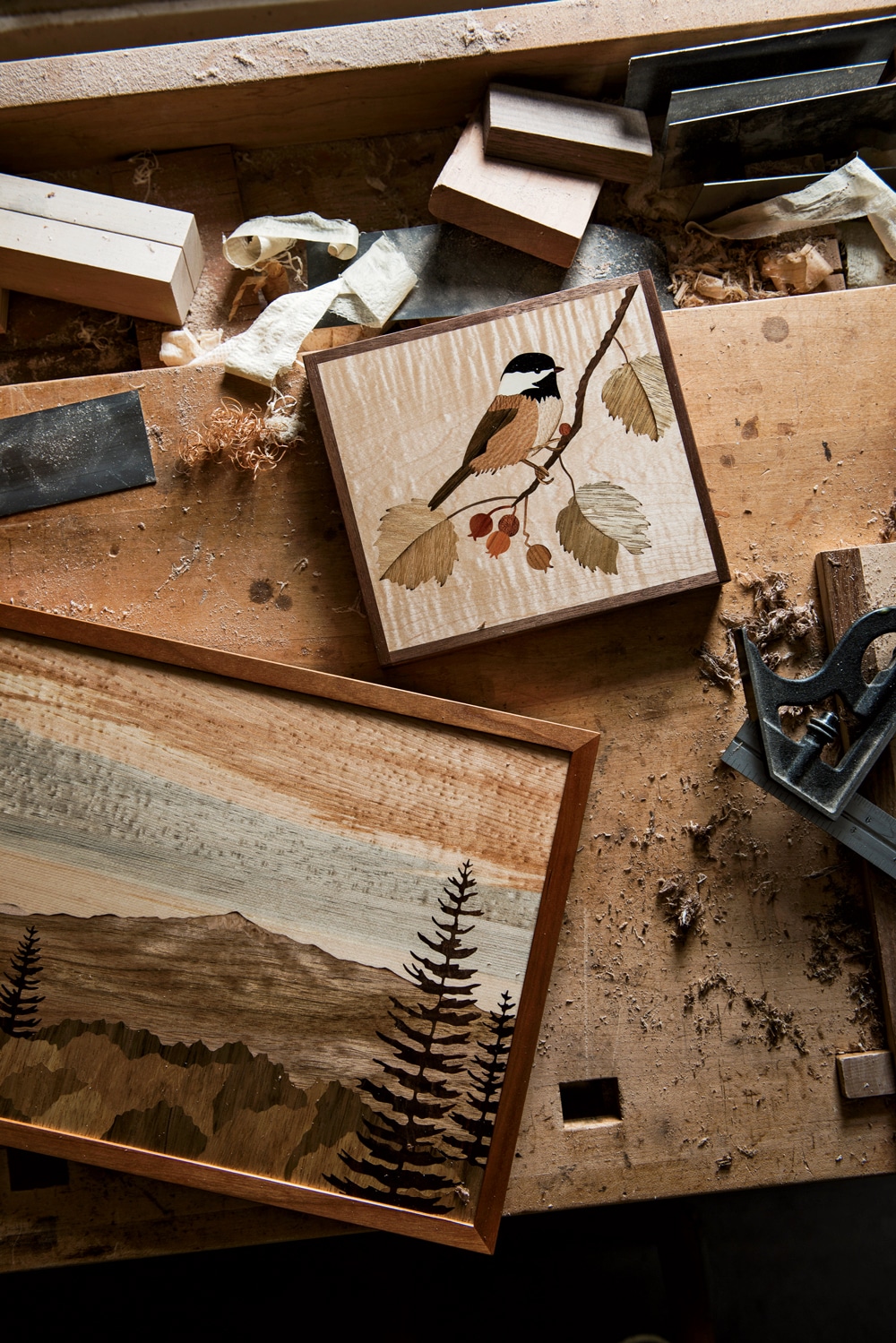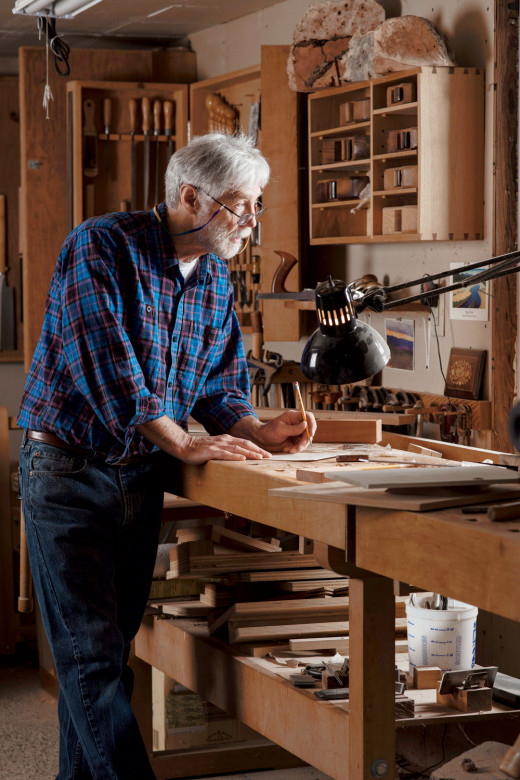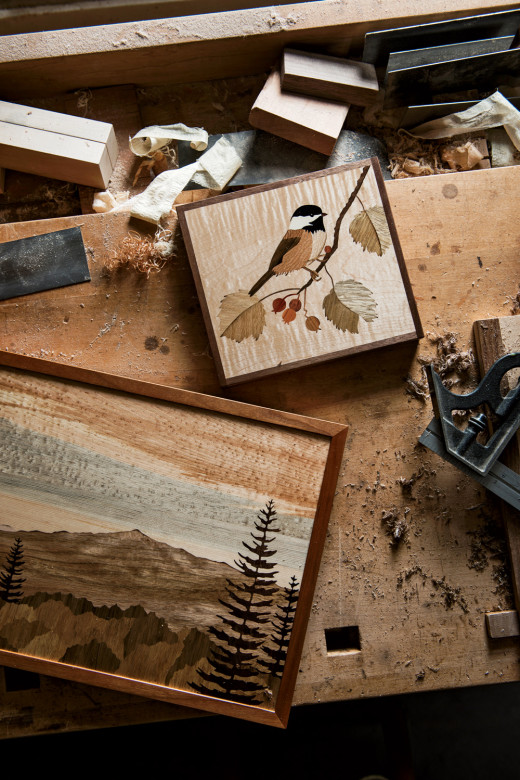Pictures Hidden in Wood | Marquetry with Craig Altobello
Craig Altobello draws on a forest of inspiration for his marquetry masterworks.

Today Craig specializes in the painstaking art of marquetry, as seen on this page.
Photo Credit : Mark Fleming
Photo Credit : Mark Fleming
A slice of walnut wood suggests a dark mountain, outlined against a rippling sky of spruce. Chickadees rendered with bits of black acacia flit across a background of pale sugar maple. A heron poses, a study in spruce and sycamore.
“There are limitations,” laughs Craig Altobello. “I can’t paint the sky, but if I open this up it suggests a sky.”
“This” is a 2-by-6-inch plank of common spruce from the local lumberyard in Peterborough, New Hampshire, where Altobello has lived for the past 26 years. He has shaved off a 1⁄16-inch slice from this plank and, with the skilled eye and hand of a practiced marquetry artist, coaxed the illusion of a pale-streaked sky from the whims and tempests of nature embedded in the wood. Using its grain and color to best advantage, Altobello has created a sky from spruce.
“I cut each layer of the same piece of wood, sometimes to the third or fourth slice. Each layer is different—but I know it when I see it. That one,” he says, holding it out to me, “suggests ‘sky.’ My palette is the wood. I’m trying to tune in to create a painterly look.”
Once he’s chosen his background, Altobello sets to work sifting through bins of thin veneers to find just the right pieces to, say, craft a kingfisher’s head, or lay out the foreground in a mountain landscape, or create the delicate wings of a dragonfly. The colors, the textures, the varieties of wood are dizzying—a palette of infinite possibilities. Or perhaps he’s simply freeing scenes and images already inside the wood.
In theory, the art of marquetry is similar to that of inlay, with cutout pieces of wood being used to create pictures. In practice, the two are fundamentally different: Where inlay features wood laid into carved-out trenches, a work of marquetry is created independent of a base, more like a puzzle of perfectly fitting pieces that is finally mounted on a piece of Baltic birch plywood that goes unseen. “Marquetry is more versatile,” Altobello explains. “With inlay you can rarely get the edges so perfect.”

Photo Credit : Mark Fleming
Perfection and play seem equal partners in Altobello’s garage workshop. Tidy, well-organized bins of thinly sliced woods are arranged by color. The woods themselves can sound like bit players in a Wizard of Oz sequel: spalted sugar maple, cherry burl, baked poplar, wenge. The equipment is just as multifarious, from a lovely cherry hand plane made by Altobello to the large DeWalt scroll saw he calls his most important piece of equipment. Though imposing, this saw is “the opposite of intimidating,” he says. “It’s like a sewing machine.” With it, he cuts the pieces that will all fall into place as a mountain scene or a bird caught midflight. From start to finish, an image can take up to a week to create.
He shows me a piece from the White Mountain series he’s working on, this one called Morning from Zealand Falls Hut, with Mount Carrigain and Carrigain Notch in the background. “I do a lot of hiking in the White Mountains,” he says thoughtfully. “I’ve hiked since I was child. It’s where my passion lies the most, so to do artwork based on hiking experiences is dear to me.”
Most of the mountain is rendered in shades of walnut that Altobello found in a lumberyard near Exeter. Creamy baked poplar from a lumberyard in Kingston suggests the mountain on the right. The silhouetted fir trees are made of wenge, a dark African wood with delicate zebralike stripes. (Though Altobello tends to favor local wood, when he does use exotics he looks for Forest Stewardship Council–certified pieces or scraps from other woodworkers.)
Is it a coincidence that Craig Altobello’s last name translates as “high beauty”? I’m still caught up in the unfinished mountain scene as he describes his latest idea for a series, depicting the old White Mountain high huts that are no longer there.
His eyes light up, and he’s off, riffling through one of the bins: “I’ve got a piece of wood over here….”
Altobello’s work is carried at the Sharon Arts Center, Peterborough, NH, and Artisans Way, Concord, MA. For more information, call 603-924-8522 or go to craigaltobello.com.
Annie Graves
A New Hampshire native, Annie has been a writer and editor for over 25 years, while also composing music and writing young adult novels.
More by Annie Graves

